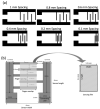Performance Optimization of Wearable Printed Human Body Temperature Sensor Based on Silver Interdigitated Electrode and Carbon-Sensing Film
- PMID: 36850466
- PMCID: PMC9964601
- DOI: 10.3390/s23041869
Performance Optimization of Wearable Printed Human Body Temperature Sensor Based on Silver Interdigitated Electrode and Carbon-Sensing Film
Abstract
The human body's temperature is one of the most important vital markers due to its ability to detect various diseases early. Accurate measurement of this parameter has received considerable interest in the healthcare sector. We present a novel study on the optimization of a temperature sensor based on silver interdigitated electrodes (IDEs) and carbon-sensing film. The sensor was developed on a flexible Kapton thin film first by inkjet printing the silver IDEs, followed by screen printing a sensing film made of carbon black. The IDE finger spacing and width of the carbon film were both optimized, which considerably improved the sensor's sensitivity throughout a wide temperature range that fully covers the temperature of human skin. The optimized sensor demonstrated an acceptable temperature coefficient of resistance (TCR) of 3.93 × 10-3 °C-1 for temperature sensing between 25 °C and 50 °C. The proposed sensor was tested on the human body to measure the temperature of various body parts, such as the forehead, neck, and palm. The sensor showed a consistent and reproducible temperature reading with a quick response and recovery time, exhibiting adequate capability to sense skin temperatures. This wearable sensor has the potential to be employed in a variety of applications, such as soft robotics, epidermal electronics, and soft human-machine interfaces.
Keywords: carbon black; flexible biosensor; human body temperature sensor; inkjet material printer; printed IDE; silver nanoparticles.
Conflict of interest statement
The authors declare no conflict of interest.
Figures








References
-
- Ali S., Khan S., Khan A., Bermak A. Developing conductive fabric threads for human respiratory rate monitoring. IEEE Sens. J. 2020;21:4350–4356. doi: 10.1109/JSEN.2020.3033047. - DOI
MeSH terms
Substances
Grants and funding
LinkOut - more resources
Full Text Sources

